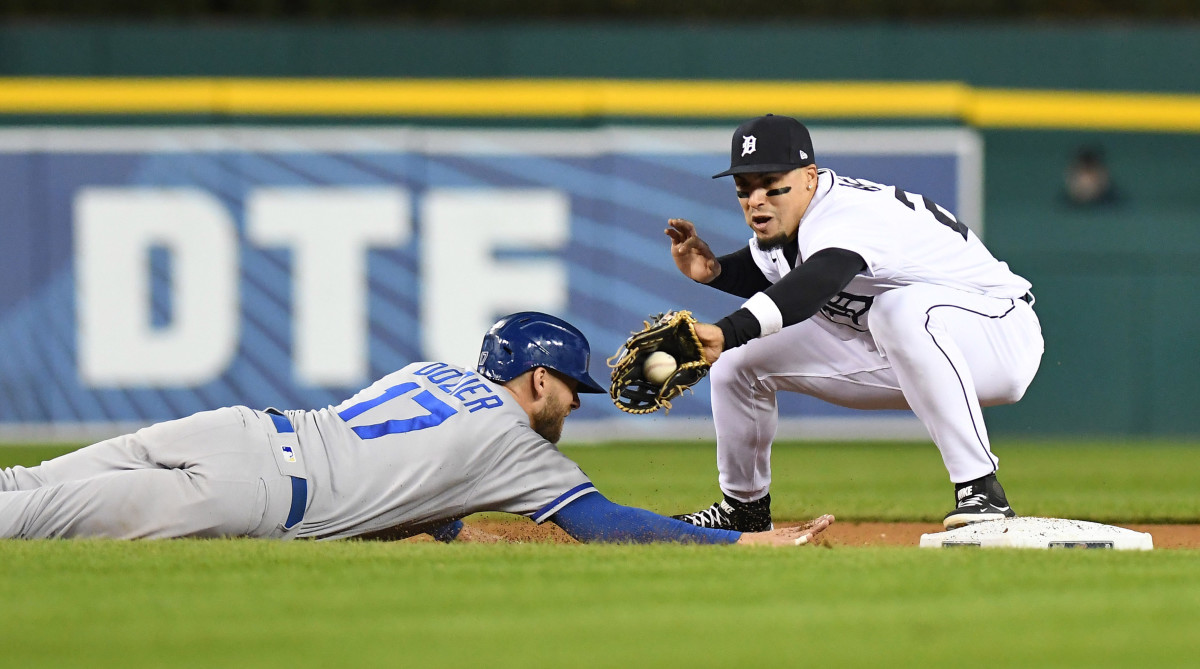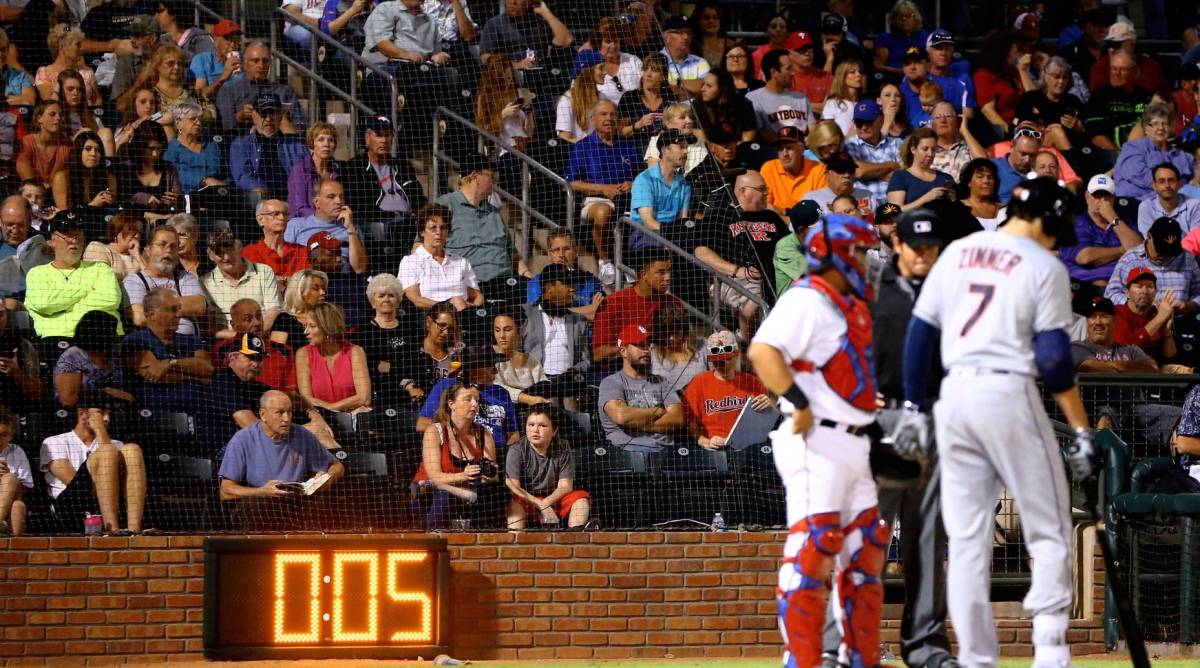MLB Executives Weighing Potential Effects of Rule Changes on Roster Construction
LAS VEGAS — If November is always a tricky month for MLB executives—free agency, trade proposals, qualifying offer decisions—there’s an extra challenge this year. The rules of the game are changing: Next season will bring a pitch clock, larger bases, a ban on infield shifts and more. All of these changes were tested in the minor leagues first. But it remains to be seen just how they’ll manifest in the majors.
So how does a front office go about making roster decisions right now?
“I want to look at these as opportunities, not necessarily challenges,” says Red Sox chief baseball officer Chaim Bloom. “Every constraint gives us a chance to find a way to win.”
The new rules were a topic of discussion at this week’s general manager meetings. Some of the consequences are fairly obvious. A left-handed hitter who faced the shift frequently over the last few years can expect his performance to improve with the switch to traditional infield alignments. A speedy runner should be able to steal more often thanks to the limit on pickoffs and the larger bases. But there are unknowns, too. Even with the awareness of how the new rules looked in the minors, there’s an understanding that some parts of the equation will be different in the majors, and savvy teams are ready to attack that gap.
“It’s going to be really interesting to see how much of an impact it makes relative to what happened in the minor leagues,” says Rays senior vice president of baseball operations and general manager Peter Bendix. “Because you can look at Triple A, or wherever, and see what happened one year to the next, but that’s not the big leagues, right? So until you actually do it … my guess is as good as yours.”
The results from Triple A and other levels provide a starting point. But teams have to pull in other sources of information to piece together their answers here.
“It’s uncharted territory,” says Phillies general manager Sam Fuld. “There are some objective ways you can try to tackle that project, but there’s definitely going to be some subjective layering on top of that.”

With the shift ban, for instance, there’s plenty of objective information available in batted-ball data. It’s simple to tell which players finished last year with the most outs that would have been hits under the new rules. But there’s a subjective portion, too: Some players have talked about the mental impact of looking up and seeing three men on the right side of the infield. Even if they weren’t trying to change their approach, there was often a subtle, unconscious effect at play. Which means that when this component disappears, there might be some players who feel the impact far more than others in ways not reflected in the data. There’s a similar dynamic with the pitch clock. It’s easy to tell which players took the most time between pitches last year. But it’s harder to tell which of those might adjust to a clock with no problem and which might struggle.
“I think we have an ability to maybe drill down on that on a more granular level with our [current] players,” Fuld says. “We know them, and we have more information on those players than the external group.”
The executives point out that almost every rule change has two sides. Most of the attention on the pitch clock has focused on what it means for pitchers—but there’s a provision of the rule that applies to hitters, too, requiring them to get in the box with eight seconds on the clock. And while most of the attention on the shift ban has been centered on what it means for hitters, there’s also a big, multifaceted question of what it will mean to defenders. If teams could previously cover up a weaker second baseman by pairing him with a shortstop and third baseman who took over some of his responsibilities with the shift—well, not anymore.
“It’s going to have defensive impact as well as offensive,” Royals executive vice president of baseball operations and general manager J.J. Picollo says. “It’s very evident that your second baseman is going to have to have that range … not being able to come off the dirt at all, needing to turn double plays, that’s going to change.”
All of these factors need to be considered when building a roster for next year. And some executives are thinking about the impact even beyond defense and offense.
“The pitch clock is going to affect everybody,” Marlins general manager Kim Ng says. “It’s coaches giving signs quickly—relaying that from the manager to the coaches, and the coaches to the players, it’s going to affect everybody in that way.”
They can look at the data from the minor leagues and extrapolate as much as possible. They can talk to their current players for some additional perspective. But most don’t want to commit to any moves that are too extreme just yet.
“We can guess and speculate, but there’s always some unintended consequences,” says Reds general manager Nick Krall. “So you don’t want to go too far overboard.”

Most executives say they’re eager to see the new rules in action. (The pitch clock, especially, received plenty of praise for how it sped up the game in the minors.) There’s an understanding that traditionalists might bristle at some of the changes. But there’s also excitement to see new strategies and possibilities.
“I'm as curious as anybody—okay, bigger bases, no shift, what adjustments do teams make?” says Angels general manager Perry Minasian. “That's the beauty about baseball. It's a chess match, right? You make one move, and the person has to counteract that move. It's really a thinking man's game. A game of adjustments. This is part of it.”
Still, executives stress that not too much is changing. There’s lots of discussion about the rule changes right now simply because they’re new. Yet their impact will be felt mostly at the margins—which, naturally, is the place many clubs look to find unexpected sources of value. But value at the margins is usually still just marginal. In other words: Yes, the rules are different, but they’re not that different.
“Good players are good players,” says Orioles executive vice president and general manager Mike Elias. “I don’t know that these rules are that dramatically different from the baseball that we know.”
More Baseball Coverage:
• Ranking MLB’s Top 50 Free Agents, With Signing Predictions
• Astros Owner Jim Crane Should Be Ashamed of His Carelessness
• The Five Best Free Agency Fits for Aaron Judge
• The Astros Are World Series Champions—No Asterisk Needed
• The Batting Cage Session That Won the Astros a Title
